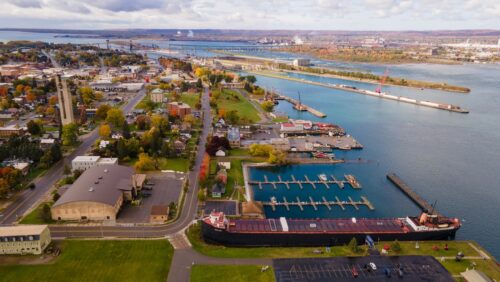Wisconsin has a small but growing community of immigrants, many of whom emigrated from Mexico. One in 20 Wisconsin residents was born in another country, while about the same share of residents are native-born Americans with at least one immigrant parent. Across sectors, foreign-born residents support the state’s economy and are vital to the state’s labor force. For example, 15 percent of all Wisconsin farmers, fishers, and foresters are immigrants, as are 13 percent of residents working in the computer and math sciences. As neighbors, business owners, taxpayers, and workers, immigrants are an integral part of Wisconsin’s diverse and thriving communities and make extensive contributions that benefit all.
Five percent of Wisconsin residents are immigrants, while another 5 percent of residents are native-born U.S. citizens with at least one immigrant parent.
- In 2018, 297,928 immigrants (foreign-born individuals) comprised 5 percent of the population.
- Wisconsin was home to 132,392 women, 141,858 men, and 23,678 children who were immigrants.
- The top countries of origin for immigrants were Mexico (28 percent of immigrants), India (8 percent), China (5 percent), Laos (4 percent), and the Philippines (3 percent).
- In 2018, 315,683 people in Wisconsin (5 percent of the state’s population) were native-born Americans who had at least one immigrant parent.
Nearly half of all immigrants in Wisconsin are naturalized U.S. citizens.
- 142,489 immigrants (48 percent) had naturalized as of 2018, and 55,443 immigrants were eligible to become naturalized U.S. citizens in 2017.
- Four in five (80 percent) immigrants reported speaking English “well” or “very well.”
Immigrants in Wisconsin are distributed across the educational spectrum.
- Nearly a third (32 percent) of adult immigrants had a college degree or more education in 2018, while over one-quarter (28 percent) had less than a high school diploma.
|
Education Level |
Share (%) of All Immigrants |
Share (%) of All Natives |
|---|---|---|
|
College degree or more |
32 |
30 |
|
Some college |
18 |
32 |
|
High school diploma only |
23 |
31 |
|
Less than a high school diploma |
28 |
7 |
|
Source: U.S. Census Bureau, 2018 American Community Survey 1-Year Estimates. |
||
Nearly 56,000 U.S. citizens in Wisconsin live with at least one family member who is undocumented.
- 75,000 undocumented immigrants comprised 24 percent of the immigrant population and 1 percent of the total state population in 2016.
- 115,747 people in Wisconsin, including 55,957 U.S. citizens, lived with at least one undocumented family member between 2010 and 2014.
- During the same period, about 3 percent of children in the state were U.S. citizens living with at least one undocumented family member (43,101 children in total).
Wisconsin is home to thousands of Deferred Action for Childhood Arrivals (DACA) recipients.
- 6,540 active DACA recipients lived in Wisconsin as of March 2020, while DACA has been granted to 8,205 people in total since 2012.
- As of 2019, 58 percent of DACA-eligible immigrants in Wisconsin had applied for DACA.
- Fewer than 2,000 residents of the state would satisfy all but the educational requirements for DACA, and fewer than 1,000 would become eligible as they grew older.
Immigrants are vital members of Wisconsin’s labor force in a range of industries.
- 191,163 immigrant workers comprised 6 percent of the labor force in 2018.
- Immigrant workers were most numerous in the following industries:
|
Industry |
Number of Immigrant Workers |
|---|---|
|
Manufacturing |
56,934 |
|
Health Care and Social Assistance |
23,387 |
|
Educational Services |
21,171 |
|
Accommodation and Food Services |
20,674 |
|
Retail Trade |
16,352 |
|
Source: Analysis of the U.S. Census Bureau’s 2018 American Community Survey 1-year PUMS data by the American Immigration Council. |
|
- The largest shares of immigrant workers were in the following industries:
|
Industry |
Immigrant Share (%) |
|---|---|
|
Administrative & Support; Waste Management; and Remediation Services |
10 |
|
Agriculture, Forestry, Fishing, and Hunting |
9 |
|
Manufacturing |
9 |
|
Accommodation and Food Services |
8 |
|
Mining, Quarrying, and Oil & Gas Extraction |
7 |
|
Source: Analysis of the U.S. Census Bureau’s 2018 American Community Survey 1-year PUMS data by the American Immigration Council. |
|
Immigrants are an integral part of the Wisconsin workforce in a range of occupations.
- In 2018, immigrant workers were most numerous in the following occupation groups:
|
Occupation Category |
Number of Immigrant Workers |
|---|---|
|
Production |
37,461 |
|
Transportation and Material Moving |
18,748 |
|
Food Preparation and Serving Related |
17,844 |
|
Office and Administrative Support |
14,433 |
|
Educational Instruction and Library |
13,780 |
|
Source: Analysis of the U.S. Census Bureau’s 2018 American Community Survey 1-year PUMS data by the American Immigration Council. |
|
- The largest shares of immigrant workers were in the following occupation groups:
|
Occupation Category |
Immigrant Share (%) |
|---|---|
|
Farming, Fishing, and Forestry |
15 |
|
Computer and Mathematical |
13 |
|
Life, Physical, and Social Science |
11 |
|
Production |
10 |
|
Building and Grounds Cleaning & Maintenance |
10 |
|
Source: Analysis of the U.S. Census Bureau’s 2018 American Community Survey 1-year PUMS data by the American Immigration Council. |
|
- Undocumented immigrants comprised 2 percent of Wisconsin’s workforce in 2016.
Immigrants in Wisconsin have contributed billions of dollars in taxes.
- Immigrant-led households in the state paid $1.7 billion in federal taxes and $968.3 million in state and local taxes in 2018.
- Undocumented immigrants in Wisconsin paid an estimated $156.9 million in federal taxes and $101.1 million in state and local taxes in 2018.
- Wisconsin DACA recipients and DACA-eligible individuals paid an estimated $15.9 million in state and local taxes in 2018.
As consumers, immigrants add billions of dollars to Wisconsin’s economy.
- Wisconsin residents in immigrant-led households had $7.1 billion in spending power (after-tax income) in 2018.
Immigrant entrepreneurs in Wisconsin generate hundreds of millions of dollars in business revenue.
- 15,458 immigrant business owners accounted for 6 percent of all self-employed Wisconsin residents in 2018 and generated $295.9 million in business income.
- In the following Wisconsin metropolitan areas in 2018, immigrants accounted for:
- 32 percent of business owners in the Chicago/Naperville/Joliet metro area (which extends from Illinois to Wisconsin and into Indiana);
- 11 percent in Minneapolis/St. Paul/Bloomington (which spans Minnesota and Wisconsin); and
- 5 percent in Milwaukee/Waukesha/West Allis.




